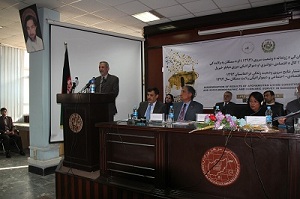Kabul, 29 November 2015 - The Central Statistics Organization (CSO) of Afghanistan launched the highlights of Samangan Socio-Demographic and Economic Survey this morning during a press event in the presence of relevant government entities, the Governor of Samangan, the United Nations and international organizations.

|

|
For this survey, approximately 800 people were hired including surveyors, supervisors, data processors, and monitors. All staff were from Samangan province in order to guarantee a fieldwork team familiar to the terrain, the people and the local culture specificities.
"Gaining accurate data is essential for developing sound policies that affect the daily lives of Afghans. Therefore the SDES is of major importance, where we collect data on village level", said the President-General of CSO, Sher Mohammad Jamizada.
The SDES is designed as a long term project to gradually gather information on population from all 34 provinces. This survey also builds CSO staff capacity in conducting large scale surveys. SDES is going to provide district level data for local development policy and planning.

|

|
"The survey is a comprehensive mechanism for collecting data on various social, demographic and economic indicators at the district and village levels depicting the status of the province against human development indicators. Accurate data at the village and district level is essential for making good decisions to respond to both problems and opportunities in the provinces. Knowing how many people live in a particular area, how and where they live and work, is essential to planning and implementing socio-economic development projects to meet people's needs and improve their lives. Generating, analyzing and disseminating population data are critical for good governance and help establish sound and successful development policies and programmes for national, regional, provincial and district levels planning", said Mercedita Tia, UNFPA's officer in charge.
Some findings of Socio-demographic and Economic Survey include:
Central Statistics Organization of Afghanistan would like to thank the people of Samangan who took part in successfully conducting the survey and hopes that policy makers and planners will use the findings of this survey to improve the lives of the population in Samangan.
About SDES:
Since 2011, UNFPA has supported the Central Statistics Organization (CSO) to conduct the provincial level Socio-Demographic and Economic Survey (SDES). Bamiyan was the first province to conduct the SDES, followed by Ghor and Daikundi in 2012. The survey has also been done in Kabul, Parwan, Kapisa and Samangan provinces. CSO and UNFPA intend to ensure that all the provinces of Afghanistan have a complete and up-to-date SDES by 2018, so that future planning occurs on the basis of robust and technically sound data.
Materials
For more information:
Central Statistics Organization
Email: mail@cso.gov.af
Web: www.cso.gov.af
UNFPA
Sahar Jahish
Media Relations
Email: jahish@unfpa.org
Tel: +93 (0)729261392
- Of the total population of Samangan, 51.0 percent are male and 49 percent female. The sex ratio is 104 males for every 100 females.
- About half of the population of Samangan were 17.5 years or younger at the time of the survey, implying a young population in the province. The 0-4 year age group constituted the largest segment of the provincial population at 16.0 percent, followed by 5-9 year age group at 15.0 percent. The 10-14 year age group comprised the third largest segment of the population which was 13.2 percent.
- Among 15 to 19 years old, around 17.6 percent were married; 53.3 percent among 20 to 24 years; 85.0 percent among 25 to 29 years old; and more than 88 percent among 30 years old and above.
- By district, Aybak, the Provincial Center, had the largest population size making up 29.4 percent of the total population in the province, followed by Dara-e-Soof-e-Payin District comprising of 18.9 percent, while Feroz Nakhcheer and Khuram Wa Sarbagh Districts had the smallest at 3.4 and 8.4 percent of the total, respectively.
- According to the survey findings, the literacy rate of the total population aged 15 years and older in Samangan Province was 28.3 percent (39.9 percent among males and 16.2 percent among females). This rate was lower than the national rate of 31.4 percent (45.4 percent among males and 17 percent among females.
- Two-thirds (66.1 percent) of the population 7 years or older in Samangan Province had not attended any formal education at the time of the survey. A larger proportion was reported among females (74.9 percent), compared with males (57.7percent).
- About 34.2 percent of the in-migrants came from abroad while 41.8 percent from other provinces and 24.0 percent lived in different districts within Samangan Province.
- More than one fourth (28.0 percent) of the births of the children below 5 years old was registered. This is lower compared to the national estimate reported at one birth in three (35.2 percent). The birth registration rate of boys was higher (28.6 percent) compared with girls (27.4 percent) in Samangan.
- In Samangan Province, among the population 15 years or older, 40.7 percent did some work for 6 months or more during the 12 months prior to the survey. A large proportion was recorded among males (72.5 percent) compared to females (7.4 percent).
- Around 85.6 percent of the ever-married women (EMW) aged 15 years or older at the time of the survey reported having given birth to at least one child.
- Of the total deaths, 28.0 percent were infants, with more male infant deaths (58 percent) compared to female infant deaths (42 percent).
- Of the estimated 79 thousand households in Samangan Province, the average household size was 5.9 persons, lower than the average at the national level (7.4 persons).
- Straw/shrub/grass is the main source of energy (36.1%) for cooking in the households.

